Birds of prey in North Dakota encompass a diverse group of raptors that inhabit the state’s landscapes. These impressive and formidable birds play a vital role in maintaining the ecological balance. These birds exhibit a range of sizes, with larger species like the Bald Eagle commanding attention and smaller ones like the Great Horned Owl showcasing their unique hunting capabilities.
Types of Birds of Prey in North Dakota
| Bird’s Name | Size | Frequency in North Dakota | Best Place to Spot in North Dakota | Best Viewing Season |
|---|---|---|---|---|
| Red-tailed Hawk | Large | Very Common | Throughout North Dakota | Spring – Fall |
| American Kestrel | Small | Very Common | Throughout North Dakota | Spring – Fall |
| Great Horned Owl | Medium | Very Common | Throughout North Dakota | All year |
| Northern Harrier | Medium | Common | Wetlands and open fields | All year |
| Bald Eagle | Large | Common | Along rivers and large lakes | All year |
| Rough-legged Hawk | Large | Common | Throughout North Dakota in winter | Winter |
| Cooper’s Hawk | Medium | Common | Wooded areas | Spring – Fall |
| Swainson’s Hawk | Large | Common | Open grasslands | Spring – Fall |
| Ferruginous Hawk | Large | Common | Prairie regions | Spring – Fall |
| Peregrine Falcon | Medium | Rare | Urban areas, large dams | Spring – Fall |
| Burrowing Owl | Small | Common | Western North Dakota | Spring – Fall |
| Turkey Vulture | Large | Common | Throughout North Dakota | Spring – Fall |
| Snowy Owl | Medium | Rare | Northern North Dakota during irruption years | Winter |
| Short-eared Owl | Medium | Rare | Wetlands and open fields in winter | Winter |
| Golden Eagle | Large | Rare | Western North Dakota | All year |
| Eastern Screech-Owl | Small | Common | Wooded areas | All year |
| Great Gray Owl | Large | Very Rare | Northeastern North Dakota during irruption years | Winter |
| Prairie Falcon | Medium | Rare | Western North Dakota | Spring – Fall |
| Broad-winged Hawk | Medium | Common | Forests and woodland areas, often near water | Spring – Summer |
Other hawks in North Dakota can include the sharp shinned hawk and other migrating hawks. Sharp shinned hawks stop at Yellowstone national park as they migrate south.
Broad-winged Hawk (Buteo platypterus)

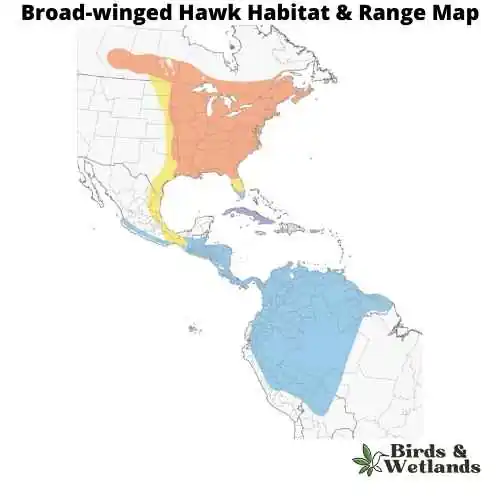
Broad-winged Hawk Sound
The Broad-winged Hawk holds a commanding presence as one of the largest hawks in the world, known for its broad wings. Its formidable size is a testament to its prowess as a bird of prey, effortlessly navigating the open skies in search of food.
Their distinctive appearance sets them apart. The adults exhibit a striking black and white pattern, complemented by a rusty breast and buff underparts and brown wings. In contrast, juveniles are adorned with a brown plumage, marked by pale edges on their feathers, adding to their distinctive youthful charm.
These hawks are most commonly found in open areas, such as farmlands or grasslands interspersed with scattered trees, which provide optimal conditions for when hawks hunt.
When it comes to their diet, Broad-winged Hawks feed on small rodents like mice, rats, squirrels, rabbits, and voles. Broad winged hawks breed during the spring and summer months then migrate to central and south America.
Red-tailed Hawk (Buteo jamaicensis)

The Red-tailed Hawk is a large bird of prey that is commonly found across North America. This species is part of the genus Buteo, which is often referred to as the “true hawks,” and includes more than two dozen species of raptors.
Red-tailed Hawks have a robust size, ranging from 18 to 26 inches in length and sporting a wingspan that can exceed 4 feet. They have a broad, rounded set of wings and a short, wide red tail. This species is most easily recognized by its rich, rust-colored tail, which gives it its common name. However, juvenile hawks might not yet have this distinctive feature.
Their feathers are generally dark brown on their dorsal side (back) with a lighter, often speckled, ventral side (front). The intensity and pattern of their plumage can vary significantly based on their age and geographic location, as there are about 14 recognized subspecies of Red-tailed Hawks.
As for their diet, Red-tailed Hawks are carnivores and have a broad diet that includes rodents, ground rabbits, reptiles, and other birds. They are skilled hunters that typically sit on high perches and use their keen eyesight to spot potential prey. Once they have identified a target, they swoop down to capture it with their powerful talons.
Red-tailed Hawks mate for life and build nests high off the ground, often in tall trees or on cliff edges. Their nests are made of sticks and can be quite large. They typically lay 1-3 eggs per year, which are incubated by both parents.
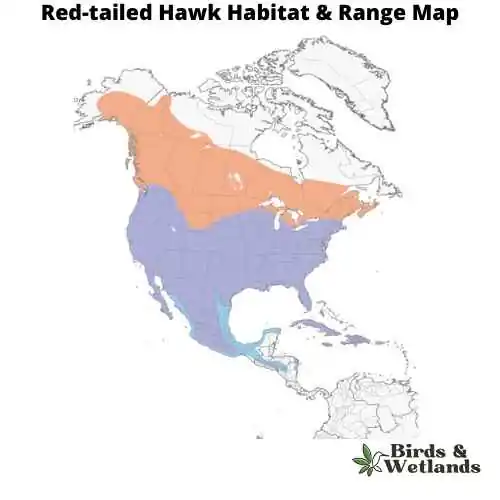
Red-tailed Hawk Sound
American Kestrel (Falco sparverius)

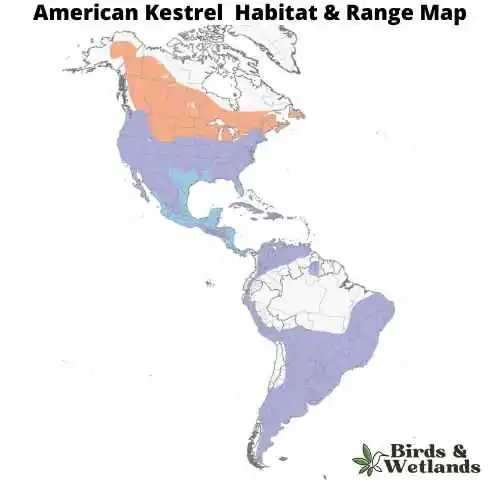
American Kestrel Sound
Scientific Name: Falco sparverius
Length: 8.7 to 12.2 in
Wingspan: 20–24 in
Weight: 3.0–5.8 oz
The American Kestrel, often recognized as the smallest and most brightly colored falcon in North America, exhibits a stunning array of rufous, blue and gray hues in its plumage. This bird, ranging in size from a mere 22 to 31 cm, carries distinct black facial markings that contrast with its white cheeks and has blue gray wings. Despite its small stature, the American Kestrel is a formidable predator, employing a unique hunting strategy that involves hovering at a height before swooping down on prey, primarily consisting of insects, small mammals, and occasionally small birds.
Residing predominantly in North and South America, the American Kestrel exhibits a preference for open habitats such as meadows, grasslands, and deserts. They are also found in both urban and suburban environments, nesting in cavities in trees, cliffs, buildings, and other structures. Kestrels are monogamous, with both sexes participating in the courtship displays that involve aerial acrobatics and feeding rituals. Nesting duties are a shared responsibility, with the male initially scouting for suitable locations and the female making the final selection. Both parents contribute to the incubation of the eggs and care of the young, ensuring the perpetuation of this captivating species.
Great Horned Owl (Bubo virginianus)
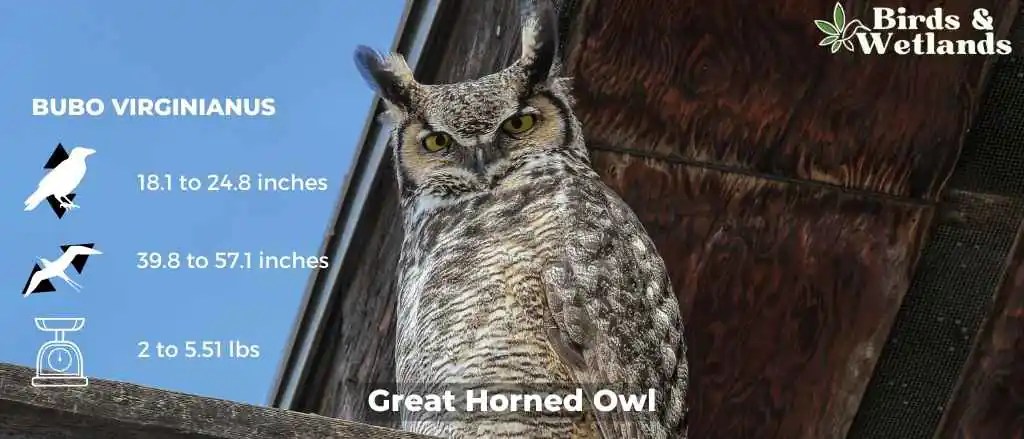

Great Horned Owl Sound
Scientific Name:Bubo virginianus
Length: 18.1-24.8 in
Wingspan: 39.8-57.1 in
Weight: 32.1-88.2 oz
The Great Horned Owl is a large owl with long wings and a large head. It’s one of the most common owls in North America.
Great Horned Owls are large, stocky birds with soft feathers that are gray to brown on their backs and white on their chests. Their faces are characterized by two black “ear” tufts, which can be raised or flattened depending on the owl’s mood. The eyes are yellow, orange, or red in color.
The habitat of the Great Horned Owl is a variety of different environments such as forests and deserts. They also live near water sources such as lakes, streams and rivers where they can hunt for fish.
The diet of the Great Horned Owl consists primarily of small mammals such as mice and rats; however they will also eat other rodents such as squirrels, rabbits and porcupines. They have been known to eat skunks too.
Northern Harrier (Circus hudsonius)

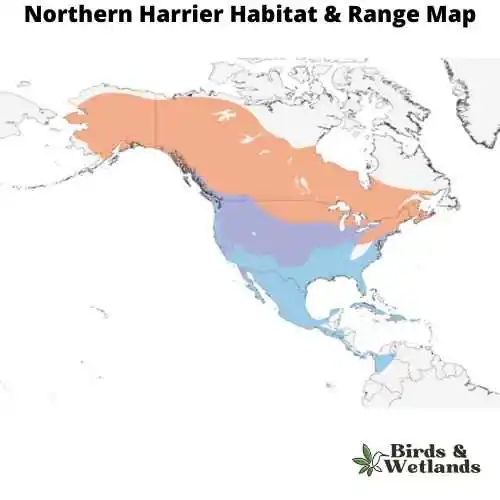
Listen:
The Northern Harrier is a medium-sized, slender hawk.
Adult birds are gray above, with pale bars on the wing feathers and white markings on the underwings and a white rump patch. The breast is barred with black and white, and the belly is streaked with brown.
They prefer open areas, such as grasslands and marshes, but can be found in almost any open habitat except dense woods.
Northern Harriers are opportunistic hunters that feed on small mammals such as mice, voles and rabbits as well as birds including quail, grouse and ducks. They hunt by flying low over open spaces such as fields or marshes.
Northern harrier nests on the ground in lowlands or hillsides near water bodies. It lays two to four eggs which hatch after 24 days of incubation by both parents. The chicks fledge after 30 days of hatching and remain dependent on their parents for another three weeks during which they learn how to fly.
Bald Eagle (Haliaeetus leucocephalus)
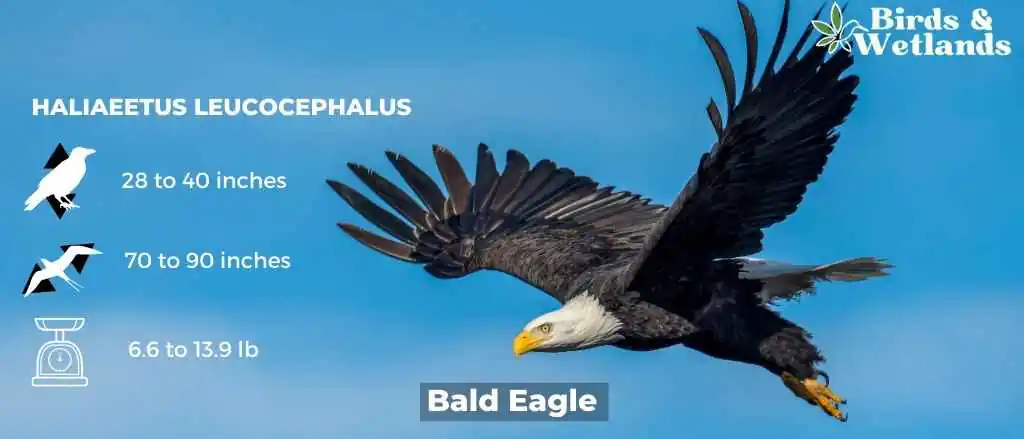
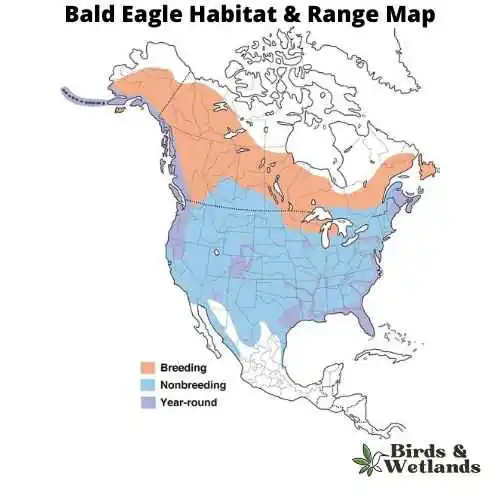
Bald Eagle Sound
Scientific Name: Haliaeetus leucocephalus
Length: 28–40 in
Wingspan: 5 ft 11 in and 7 ft 7 in
Weight: 6.6 -13.9 lb
The Bald Eagle, primarily found in Canada and Alaska, is instantly identifiable by its white head, dark brown body, yellow beak, and a piercing cry. Its sharp, orange-yellow eyes aid in efficient night hunting.
Predominantly residing in North America, occasionally venturing into Asia and Europe, it thrives near water bodies. It perches atop trees, providing a bird’s-eye view of its prey. It feeds on fish, carrion, small mammals like rabbits and squirrels, and reptiles. Hunting involves a swift downward swoop to seize the prey, carrying it back to the nest.
Bald Eagles are monogamous, forming lifelong pairings. They construct vast nests from sticks, lined with moss or grasses. They typically lay 1-3 eggs annually, which hatch around 35 days later. The fledglings leave the nest roughly 6 weeks after hatching, but continue to rely on their parents for nourishment for a further 5-6 months, until they become proficient hunters.
Rough-legged Hawk (Buteo lagopus)

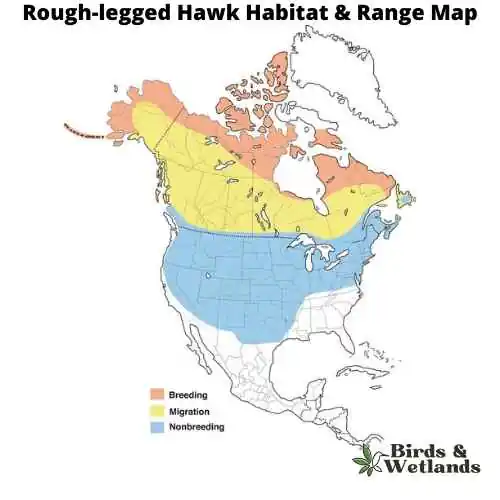
Rough-legged Hawk Sound
The Rough-legged Hawk is a large, raptor that is native to North America. It is also known as the American Rough-legged Hawk. Scientific Name: Buteo lagopus
The Rough-legged Hawk is a medium-sized hawk with a distinctive appearance, with dark brown feathers on its back and light brown feathers on its underside and broad thin wings. The hawk’s legs are also covered in dark feathers, which help to distinguish it from other species of hawk. The tail is barred with black and white. They have yellow eyes and dark feet.
Rough-legged Hawks hunt from above ground level, swooping down to catch its prey in its talons. When hunting for food, they prefer to eat small mammals such as squirrels and rabbits but will also eat birds if there aren’t any small mammals available. Although they eat a variety of small animals including birds, rodents, bats and reptiles, they rely heavily on fish for food during breeding season because it provides them with protein and calcium needed to produce eggs.
Cooper’s Hawk (Accipiter cooperii)
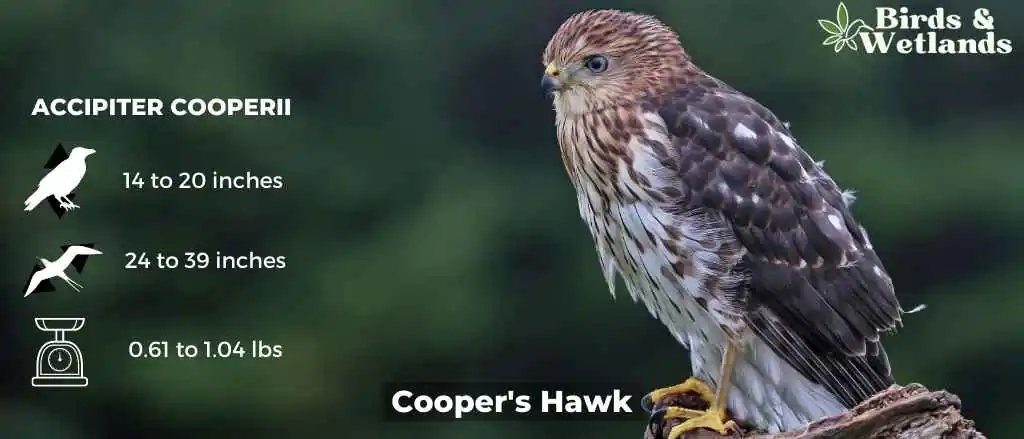
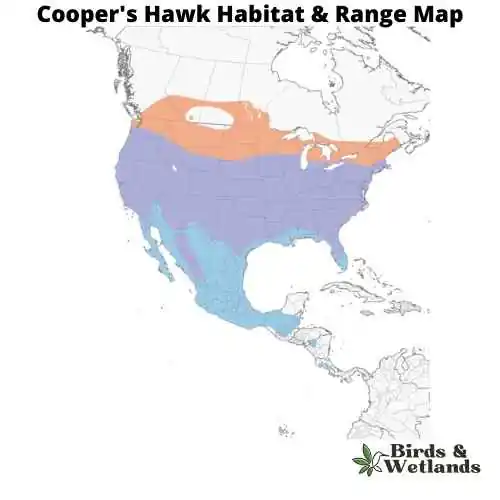
Listen:
The Cooper’s Hawk is a medium-sized bird of prey native to North America. Known for its agility and speed, it is part of the Accipitridae hawk species, which also includes other hawks, eagles, and kites.
Cooper’s Hawks are typically about 14 to 20 inches in length, with a wingspan ranging from 27 to 36 inches. They are known for their distinctive long, rounded tails and short, rounded wings. They have a steely blue gray top, with rusty bars on their underparts and thick, dark bands on their tails.
The Cooper’s Hawk is a skilled predator, primarily hunting birds and small mammals. They are adept at hunting in both dense forests and open areas, often catching prey mid-air in high-speed pursuits. They have also been known to visit the backyard bird feeder, not for the seed, but to prey on the smaller birds that gather there.
Cooper’s Hawks often build nests in dense tree canopies where they are well concealed. The female usually lays 3 to 5 eggs, and both parents share incubation duties. The young hawks fledge after about a month but will stay close to the nest, relying on their parents for food as they learn to hunt.
Swainson’s Hawk (Buteo swainsoni)
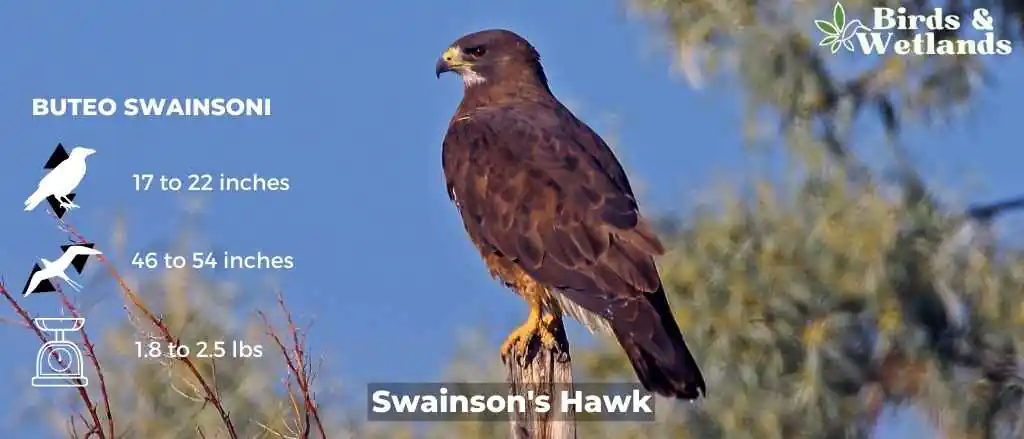
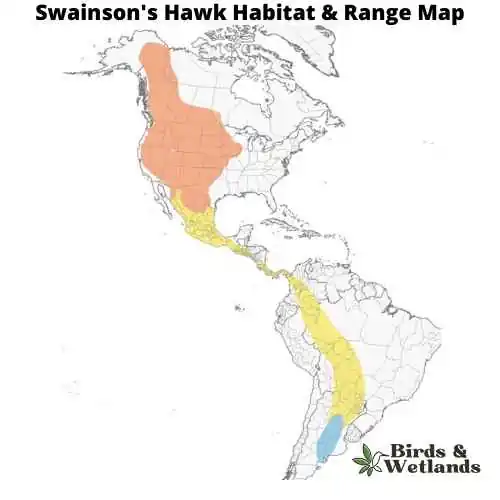
Listen: Swainson’s Hawk
Swainson’s Hawk is a medium-sized hawk that is found in North America and South America, Scientific Name: Buteo swainsoni.
The bird has a blue-gray plumage with a dark brown back, wings, and tail. It also has a white chest and belly. The beak and feet are black, but the eyes are yellow. They are often confused with Cooper’s Hawk because of similar coloring, but Swainson’s Hawks have wider tails and longer wings than their cousin species.
These birds eat small rodents such as gophers and mice. They also eat insects like grasshoppers and crickets during the summer months when they’re plentiful. They sometimes steal prey from other birds of prey such as Northern Harriers who hunt the same prey.
Swainson’s Hawks build nests on rocky cliffs near water sources where they can find food easily. They lay three to five eggs that hatch after about two months into fluffy brown baby hawks who leave the nest after about three weeks (or when they’re big enough).
Ferruginous Hawk (Buteo regalis)

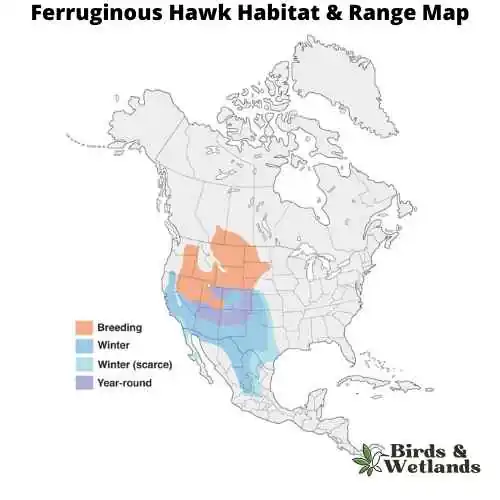
Ferruginous Hawk Sound
Scientific Name: Buteo regalis
Length: 20 to 27 in
Wingspan: 48 to 60 in
Weight: 32.0 to 80.0 oz
The Ferruginous Hawkis the largest hawk species native to North America. Known for its distinctive coloration and impressive size, this bird of prey predominantly inhabits the open landscapes of the western United States and parts of Canada.
Ferruginous Hawks are notable for their “ferruginous” or rust-colored back and shoulders, which contrasts sharply with the bird’s white underside. The hawk also has broad, rounded wings and a large, gape-mouthed beak. Ferruginous hawks exhibit dark morph and light morphs. Dark morphs have dark brown plumage, while light morphs display lighter, reddish-brown plumage. Morphs vary geographically.
Primarily feeding on small to medium sized mammals like rabbits and prairie dogs, the Ferruginous Hawk is an agile hunter, often seen soaring high above the ground or perched prominently while scanning for prey. It occasionally feeds on birds, reptiles, and insects as well.
Nesting for Ferruginous Hawks typically occurs on cliffs, hillsides, or large trees. The female lays between 2 to 5 eggs, and both parents share in the incubation and rearing of the chicks. The Ferruginous Hawk is a relatively solitary bird outside of the breeding season, and its call is a loud, high-pitched scream, often heard during courtship or near the nest.
Peregrine Falcon (Falco peregrinus)


Peregrine Falcon Sound
Scientific Name: Falco peregrinus
Length: 14.2-19.3 in
Wingspan: 39.4-43.3 in
Weight: 530-1600 g
Known for its blue-gray plumage and unique cheek bars, the Peregrine Falcon stands as a beacon of power and swiftness. Despite its modest size, it reigns as the world’s fastest creature, reaching staggering speeds up to 240 mph during hunting dives.
Its diet mainly includes birds, occasionally bats, caught in an enthralling aerial display of agility and precision. Adapting to diverse habitats, this bird graces every continent except Antarctica, finding home in environments from city skyscrapers to towering cliffs.
Peregrine Falcons, monogamous in nature, often pair for life, expressing their bonds through complex courtship flights filled with intricate aerial maneuvers. They construct simple scrape nests on high ledges, often without adding materials.
Their parenting duties are shared, from egg incubation to feeding and caring for the chicks, ensuring their offspring are ready to take on the skies in their own time.
Burrowing Owl (Athene cunicularia)


Burrowing Owl Sound
Scientific Name: Athene cunicularia
Length: 7–11 in
Wingspan: 20–24 in
Weight:5–8 oz
The Burrowing Owl is a small, long-legged species of owl found in North and South America. Known for its unusual habit of living in burrows in the ground.
Burrowing Owls have a rounded head with no ear tufts and bright yellow eyes. Their overall coloration is mottled brown and white with a distinct white “eyebrow” above each eye.
Their primary habitat includes open landscapes such as grasslands, deserts, agricultural areas, golf courses, and even airports. As their name suggests, these owls often reside in burrows, many of which are abandoned by prairie dogs, ground squirrels, or other burrowing animals. In some cases, they may also dig their own burrows.
Burrowing Owls diet consists mainly of small mammals and insects, but they also eat birds and reptiles.
Burrowing Owls have a unique nesting behavior. They lay their eggs in an underground burrow to protect them from predators and extreme weather. Clutch sizes range from 6 to 11 eggs, which are incubated for about a month before hatching.
Turkey Vulture (Cathartes aura)


Turkey Vulture Sound
Scientific Name: Cathartes aura
Length: 24–32 in
Wingspan: 63–72 in
Weight: 1.8 to 5.3 lb
Turkey vultures are large birds that are easily recognizable by their bald heads, which are black in coloration, and by the patch of red skin below their beaks. It is white with black spots on the wings and tail. It has a bald head and a hooked beak that is black in coloration.
Turkey vultures live in the Americas, Europe, Africa, and Asia. They can be found in deserts, grasslands, forests and swamps. Turkey vultures are found throughout North America and parts of Central America and South America. In the U.S., they can be found across the country, but most commonly in the southwest region.
Turkey vultures eat carrion—dead animals’ remains such as dead deer, sheep, cows, horses and other large mammals that have been killed by other predators, such as coyotes or foxes. They do not hunt live prey.
Snowy owl (Bubo scandiacus)

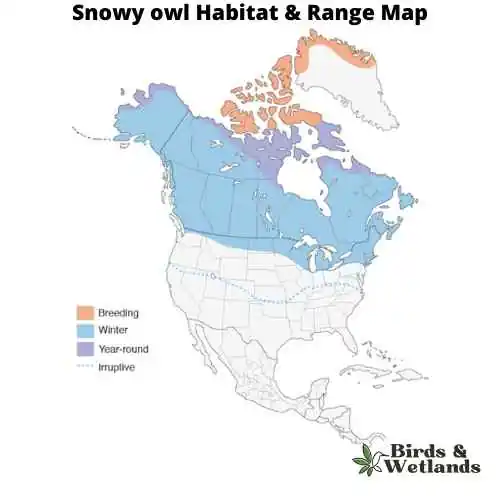
Snowy owl Sound
Scientific Name: Bubo scandiacus
Length: 20.7 to 28 in
Wingspan: 3 ft 10 in to 6 ft 0 in
Weight: 3.2lb to 5.3lb
The Snowy Owl, is of the most well-known species of owls, the Snowy Owl is renowned for its striking appearance and adaptations to its extreme environment.
Snowy Owls are medium sized birds that possess a rounded head, yellow eyes, and a black beak. The most distinctive feature of the Snowy Owl is its white plumage, which provides effective camouflage in its snowy habitat. Male Snowy Owls are often almost completely white, while females and younger owls have more extensive dark barring on their plumage.
Unlike many owl species, Snowy Owls are primarily diurnal, which means they are active during the day. This is an adaptation to life in the Arctic, where there can be 24 hours of daylight in the summer. Their diet mainly consists of small mammals, particularly lemmings, but they are known to eat a variety of animals including birds, fish, and even carrion when necessary.
Snowy Owls nest on the ground, usually on a mound or boulder. Their breeding success is closely tied to the availability of food, and in good years a single pair of owls can raise a large brood of chicks.
Short-eared Owl (Asio flammeus)
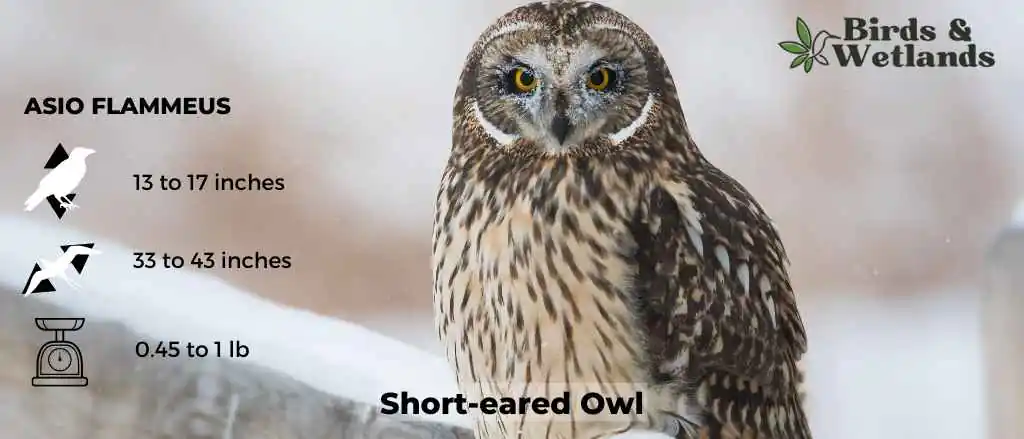
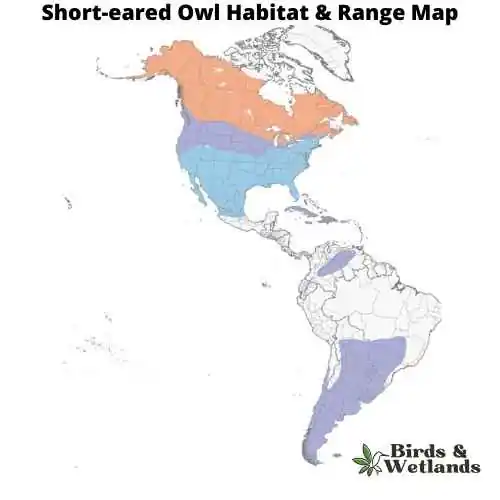
Short-eared Owl Sound
Scientific Name: Asio flammeus
Length: 13–17 in
Wingspan: 33 to 43 in
Weight: 7.3–16.8 oz
The Short-eared Owl is a medium-sized owl species with a wide distribution, found across North and South America, Europe, Asia, and many Pacific islands. Despite its name, the “ears” of the Short-eared Owl are not often visible, as they are small and tend to blend with the bird’s feathers.
The owls are predominantly brown with buff and white accents throughout their body and wings, and dark patches around their yellow eyes.
Short-eared Owls diet consists largely of small mammals, especially voles. However, they are opportunistic hunters and will also prey on a variety of other animals, including other birds, when available.
Their habitat is characterized by open areas like grasslands, marshes, and tundra. They nest on the ground, which is unusual for owls, and this makes them vulnerable to ground predators. As such, they often live in areas with tall grasses or other ground cover for protection.
Golden Eagle (Aquila chrysaetos)
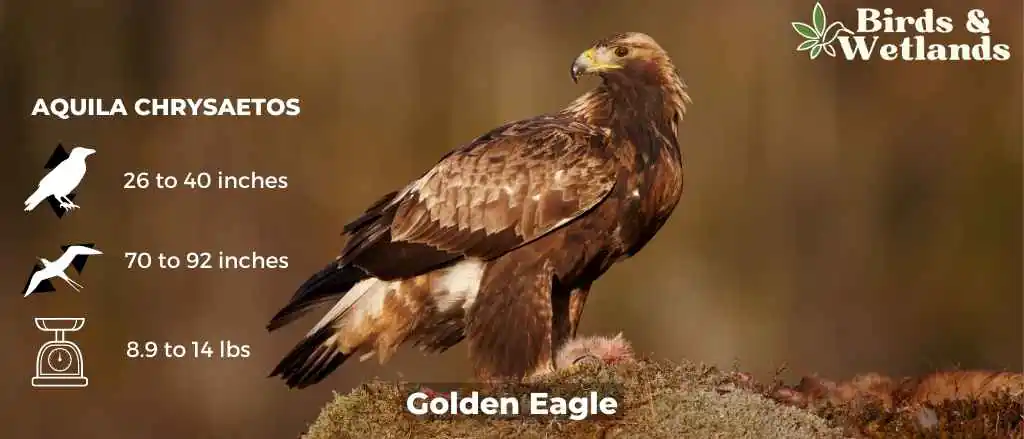

Golden Eagle Sound
Scientific Name:Aquila chrysaetos
Length: 26 to 40 in
Wingspan: 5 ft 11 in to 7 ft 8 in
Weight: 8.9 and 14.0 lb
The Golden Eagle is a large bird of prey known for its strength, speed, and hunting prowess.
Adult Golden Eagles are large birds, and are named for the golden-brown plumage on their heads and necks, which contrasts with their darker brown body feathers. Their eyes, legs, and bill are all yellow.
These eagles prefer open, rugged terrain, including mountains, hills, grasslands, and deserts. They are most often found in areas that provide good opportunities for soaring and hunting.
Golden Eagles have a varied diet but primarily prey on small to medium-sized mammals such as rabbits, hares, and ground squirrels. They are also capable of taking larger prey, like young deer or livestock, but these are not typically part of their diet.
Golden Eagles build large nests or eyries, usually on cliffs or in tall trees. The nests are often reused and added to each year, becoming enormous structures over time. The female typically lays 1 to 4 eggs, which both parents incubate.
Eastern Screech-Owl (Megascops asio)
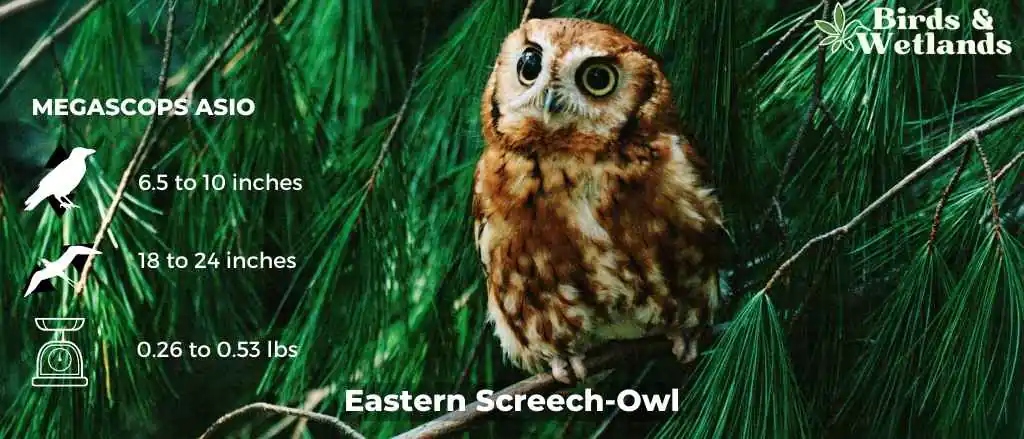
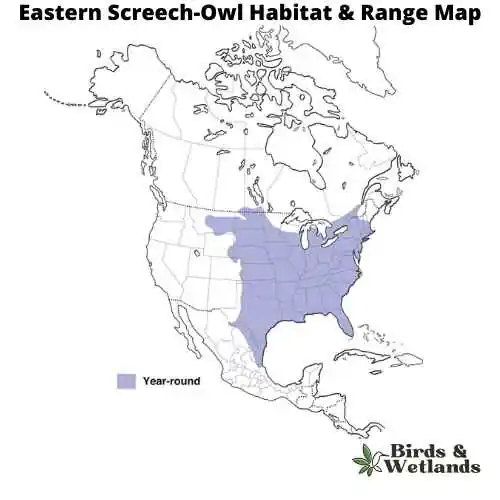
Eastern Screech-Owl Sound
Scientific Name: Megascops asio
Length: 6 to 10 in
Wingspan: 8 to 24 in
Weight: 4 – 8.5 oz
The Eastern Screech-Owl is a small owl species native to most wooded environments of the eastern half of North America, from the Canadian provinces to Florida and Texas.
Eastern Screech-Owls are relatively small and exhibit a complex pattern of gray or reddish-brown coloration, which provides excellent camouflage against tree bark.
These owls are known for their distinctive call, which is often described as a haunting trill or a whinny-like sound. Despite their name, they do not actually produce a “screech.”
Eastern Screech-Owls feed on a variety of prey, ranging from small mammals and birds to insects and even earthworms. It is primarily nocturnal, hunting at night from a low perch and swooping down onto prey.
Eastern Screech-Owls nest in tree cavities or abandoned woodpecker nests, but they readily adapt to nesting boxes where natural cavities are not available. They typically lay between 2 to 6 eggs, which are incubated primarily by the female.
Great Gray Owl (Strix nebulosa)


Great Gray Owl Sound
Scientific Name: Strix nebulosa
Length: 26 in to 28 in
Wingspan: 56 to 60 in
Weight:2.2 lb to 2.85lb
The Great Gray Owl, or Strix nebulosa, is a very large owl, native to the boreal forests across North America and Eurasia. Despite its great size, it’s more so known for its impressive appearance rather than its weight, as it is outweighed by several other large owl species.
The Great Gray Owl has a large, rounded head with a grey face and yellow eyes, surrounded by concentric circles of dark and light feathering. It is known for its bow-tie-shaped white moustache stripe and black chin spot.
One of the distinguishing characteristics of this owl is its elongated tail, which makes it appear much larger than it actually is. The plumage is mostly grey with a unique pattern of fine white, gray, and brown streaks and bars. Despite its large size, its diet primarily consists of small rodents, like voles and pocket gophers.
Great Gray Owls prefer dense coniferous forests, often near open meadows or bogs. Rather than building their own nests, they typically use nests previously built by other large birds, such as hawks or crows. They also occasionally nest in broken-top trees or on man-made structures.
Prairie Falcon (Falco mexicanus)
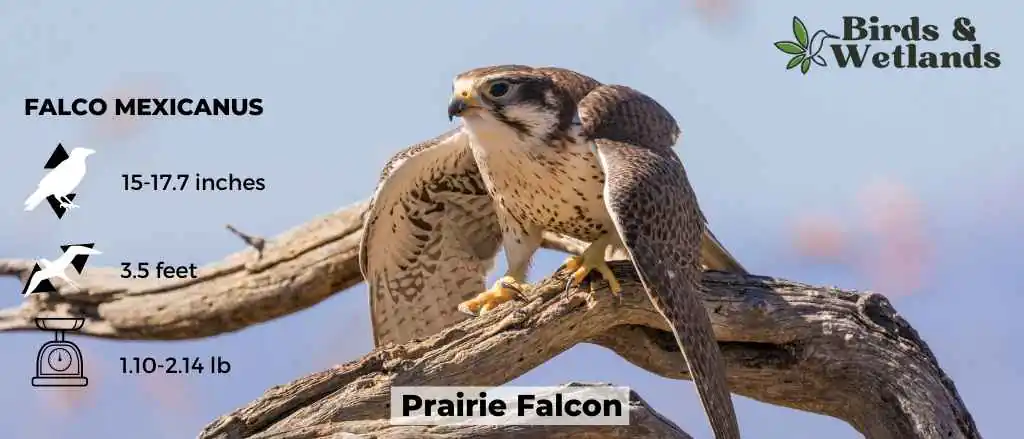

Prairie Falcon Sound
Scientific Name: Falco mexicanus
Length: 15 in – 17.7 in
Wingspan: 3.5 feet
Weight: 1.1 to 2.1 lbs
The Prairie Falcon, is a large falcon species that inhabits the open landscapes of North America, particularly in the western regions of the continent. Known for its agility and speed, this bird of prey is a skilled hunter and a master of flight.
Prairie Falcons sport a distinct color pattern with a pale, buffy brown body, contrasted with darker wingtips and a characteristic “mustache” mark near the eyes, a feature common to many falcons.
The Prairie Falcon’s diet primarily consists of small mammals and birds. It is known for its high-speed aerial pursuits, diving onto its prey from great heights. This agile predator often utilizes the open terrain of its habitat, making swift, low-level flights to catch prey off-guard.
Nesting for the Prairie Falcon often takes place on high cliff ledges, where it lays a clutch of 3 to 5 eggs. After hatching, the young falcons remain in the nest for up to six weeks, continuing to rely on their parents for food until they master hunting skills.
Where to Spot North Dakota’s Birds of Prey
Theodore Roosevelt National Park: Nestled in the Badlands of western North Dakota, this national park provides an ideal habitat for birds of prey. Here, you can spot Golden Eagles, Red-tailed Hawks, and Peregrine Falcons soaring above the rugged terrain.
Lostwood National Wildlife Refuge: This vast refuge in northwestern North Dakota is known for its mixed-grass prairie environment, which attracts a variety of raptors like Northern Harriers, Ferruginous Hawks, and Swainson’s Hawks.
Arrowwood National Wildlife Refuge: Located in the wetlands of eastern North Dakota, this refuge is home to several species of birds of prey, including Bald Eagles, Cooper’s Hawks, and Red-tailed Hawks. Its lakes and marshes provide ample hunting grounds for these raptors.
Chase Lake National Wildlife Refuge: As one of the oldest refuges in the U.S., it’s a known breeding area for many birds, including birds of prey. Look for Prairie Falcons, Bald Eagles, and Northern Harriers in this area.
Lake Sakakawea State Park: This large reservoir on the Missouri River provides excellent opportunities to see various raptors, particularly Ospreys and Bald Eagles, that frequent the water’s edge for fishing.
North Dakota’s expansive prairies host a range of birds of prey. Witness the natural resilience reflected by Montana’s Feathered Predators. Head south to South Dakota, where the Skyborne Hunters mirror the Mount Rushmore State’s dynamic landscapes. To the east, Minnesota’s Winged Warriors echo the Land of Ten Thousand Lakes’ rich biodiversity. Uncover more about these captivating creatures with our comprehensive Guide to American Raptors.

